17+ Best Scheduling Software of 2021 Reviews (Ultimate Guide)

Businesses and professionals are continually striving to make their workflows more efficient, robust, and reliable. The best scheduling software is playing a larger and larger role.
Today, businesses have to deal with tons of meetings, appointments, employee scheduling, workforce management, and other complex business processes. It becomes daunting for both individuals and businesses to keep track of the schedule and ensure business efficiency.
And typical systems are not enough to manage messages from emails, texts, and other digital channels.
In such cases, professionals and organizations need a smart system to make things smooth and organized at the workplace.
And this is where scheduling software comes into play.
A good scheduling tool can help businesses increase customer engagement, optimize resource and project management, and streamline business operations. Organizations can also leverage scheduling software to minimize paperwork, workflow gaps, and please their customers to make more money online.
To help you out, I ranked and reviewed the best scheduling software available today.
Let’s get started.
Disclaimer: This article contains affiliate links that I receive a small commission for at no cost to you. However, these are merely the tools I fully recommend when it comes to scheduling software. You can read my full affiliate disclosure in my privacy policy.
What is the Best Scheduling Software?
Here’s a list of some of the best scheduling tools, along with their key features, pros, cons, and pricing plans.
1. Acuity Scheduling.
Best Overall Appointment Scheduling Software.

Acuity Scheduling offers scheduling solutions to users who need to access their availability in real-time and make appointments depending on their pre-planned schedule. The software is famous for being highly functional and delivering a friendly user interface.
Moreover,
it enables clients to monitor their daily schedules easily and eliminate any kind of miscommunication.Key Features:
- It allows the user to track revenue based on the details of unpaid and paid appointments. Users can also flag no-shows and take a record of fulfillment plus hours given per appointment.
- It offers easy customization options to meet diverse requirements.
- Acuity Scheduling allows sharing your calendar on social media, including Facebook and Twitter. It can also be shared through email and embedded on a website so people can book their own appointments.
- It provides end-to-end protection of customer information on both web and mobile devices.
- It offers secure online transactions through several avenues, including PayPal and Stripe.
- It provides easy integration with Squarespace, iCal, and Zapier.
Cost:
It comes with a free trial. The paid plans start at $15 per month up to $50 per month, based on your scheduling needs.
Get started with Acuity Scheduling.
2. SimplyBook.
Best For Service-Based Companies.

SimplyBook is the best online scheduling tool available on the market for service businesses.
It’s an especially great solution for service-based businesses and you can get a professional website with a full booking system. This gives you the ability to add “Book Now” button widgets on your website or on Facebook, Instagram, and Google profiles.
SimplyBook also offers the ability to accept payments online via their POS system and has a lot of other great marketing features. From offering video meetings and sending marketing emails to providing coupons, and gift cards, their software is a one-stop solution for service businesses.
Key Features:
- It enables automated delivery of booking confirmation email and SMS. And the users can cancel the booking at any point in time.
- You have the ability to issue tickets in the form of QR codes.
- You can easily embed the booking page on your social profiles and website.
- Users can leverage its extensive setting features to offer multiple services and club offers in meaningful packages.
- It allows businesses to receive online payments from several payment avenues. The payment avenues include Skrill, Bitcoin, Dwolla, PayPal, Mollie, CCAvenue, Zooz, and PayFort.
- Easily sync available time and booking transactions through the Google Calendar Sync plugin.
- Its intuitive dashboard offers all the data, including booking transactions and their statuses, through different colors for easy accessibility.
- It offers efficient integration with Google Analytics to track visitors and engagement.
- It also offers a reward system through which businesses can encourage their existing customers to promote their business.
- You can easily create classes and events through its newly launched Class & Membership functionality.
- There are custom features in every plan, which include add-ons to extend the functionality of your bookings.
Cost:
It offers a free plan and free trial of its paid plans that start at $9.90 per month up to $59.90 per month.
- Free Plan – includes a booking website with up to 50 bookings and one custom feature.
- Basic Plan ($9.90/month) – includes up to 100 bookings, 3 custom features, and adds POS and coupons/gift cards.
- Standard Plan ($29.90/month) – gives you up to 500 bookings and 8 custom features, and adds HIPAA regulations.
- Premium Plan ($59.90/month) – provides up to 2,000 bookings, unlimited custom features, and adds link removal, which removes the Simplybook.me text from your widgets.
Get started with a 14-day free trial of SimplyBook.
3. HubSpot Meetings.
Best Free Meeting Scheduler with Built-In Marketing Tools.

HubSpot’s meeting scheduling tool provides you with a personalized booking link you can use to invite people to view your availability and book meetings with you. When someone schedules a meeting, their contact details will automatically be added to your calendar and pushed to the HubSpot CRM database (the CRM is free-forever, for unlimited users).
HubSpot Meetings integrates with both Google Calendar as well as Office 365 and is part of HubSpot’s All-In-One WordPress plugin. When you sign up for HubSpot Meetings, you’ll gain access to HubSpot’s free CRM, marketing, sales, and customer service tools including email marketing automation, live chat, and forms, as well as HubSpot Academy, a free online educational resource.
Key features:
- Personalized booking link and customizable booking page (headshot, logo, color palette)
- Integration with both Google or Office 365
- Group meetings link to allow prospects to schedule time with more than one person in your organization
- Custom form questions to provide you with valuable context about your contact before the meeting
- Available as part of HubSpot’s free All-In-One WordPress plugin
- Ability to embed your calendar on your website
Cost:
- Free Plan – Includes one personalized meeting link, unlimited meetings, integration with HubSpot’s free-forever CRM, and the ability to embed a calendar on your website.
- Starter Plan ($50/month) – Includes all the other paid features of HubSpot Sales, as well as 1,000 personal and team meetings links.
Get started with HubSpot Meetings.
4. Setmore.

Setmore offers robust online scheduling solutions for individual entrepreneurs, small businesses, organizations, and NGOs.
It is capable of streamlining a plethora of processes that include payments, online booking, scheduling, and client engagement. Moreover, the software comes equipped with easy to use administrative features and enhances the efficiency of the workflow.
Key Features:
- It is compatible with any device, including desktops, tablets, and smartphones to give the flexibility to use it from any location and at any point in time.
- It offers text reminders and mobile scheduling to prevent users from missing an appointment.
- Businesses can give access to in-house employees to manage appointments made by users.
- It offers SMS and email alerts for every rescheduled and canceled appointment.
- Setmore enables clients to make appointments through social media platforms, including Facebook. It allows easy integration with Facebook and the website.
- Businesses can leverage website widgets to facilitate faster delivery.
- Its highly optimized payment processing feature enables faster transactions through cards.
- It offers robust customer support that responds almost instantly.
Cons:
- The user interface looks a bit dated.
- Integration with third-party apps can be more reliable and robust.
Cost:
It offers a freemium plan with all the necessary functions and no credit card required. The paid plans start from $25 per month.
Get started with Setmore.
5. Calendly.

Calendly offers an intuitive and straightforward user interface that is suitable to assist small and medium-sized organizations.
This appointment scheduling software helps businesses to enhance service quality, increase sales numbers, and encourage savings at the same time.
Moreover, Calendly efficiently eliminates the need to manually schedule appointments, calls, interviews, and demos, among others.
Key Features:
- Non-technical users can efficiently use Calendly due to its easy to navigate user interface.
- After the client or colleague chooses a date, it automatically updates it in the calendar.
- It offers robust integration with Office 365, Google, and Outlook.
- It cross-checks all calendars to avoid conflicts and double bookings.
- Users can send automated invites through custom reminders and confirmation features.
- It is compatible with all the devices, including desktops, tablets, and smartphones. It means that you can use the platform from any location at any point in time.
- The software allows the user to check whether the team is available or not and automated email reminders and follow-up.
- Multiples invitees can schedule similar slots for webinars, class, or workshop. Invitees can also make an appointment without having to register or sign up on the platform.
- It also offers robust email support.
Cons:
- Email support is available for the premium version of Calendly.
- It can connect to only one calendar per account.
- Sometimes it misreads the data and schedules false appointments.
Cost:
It offers a free version with all the essential features. The paid pricing plans start at $8 per month per user. You also get a 14-day free trial for the paid plans.
6. Findmyshift.

Findmyshift is an employee scheduling software that is perfect for creating employee schedules, tracking your labor costs, managing shift requests and timesheets, and communicating with employees efficiently.
The cloud-based scheduling platform offers a user-friendly interface that can be easily used by non-technical people. The best part is that it provides a stable, reliable, and scalable scheduling process for organizations of all sizes and types.
Key Features:
- Easily track all the staff from one place.
- Leverage any web browser to create and schedule duties from anywhere and share it with employees instantly.
- It offers a one-month free trial with all the premium features.
- Use its time clock application to track employee work hours and work schedules. This tool comes with a zero subscription fee.
- Findmyshift comes with highly functional Android and iOS applications to keep employees connected on the move.
- Teams of up to 5 people can use free employee scheduling software to easily create employee schedules.
- Send notifications and messages to employees through text messages, emails, and push notifications.
- Send automated shift reminders and conduct shift scheduling in one dashboard.
- Use its smart pay rate calculation to pay employees with different hourly rates accurately.
- Secure all the data in the cloud with automated backups.
Cons:
- Clock-in time can’t be adjusted manually if an employee forgets to clock in.
- The desktop version’s user interface looks a bit dated.
- The options may seem limited for a large organization.
Cost:
It offers a free version for up to 5 employees. You also get a 1-month free trial for the paid versions that start from £16.50 per team.
7. Bitrix24.

Bitrix24 offers robust and collaborative features that automate scheduling systems to address the business needs of companies of all sizes. It can easily manage your messages, files, emails, contacts, tasks, and projects, among others.
Key Features:
- Businesses can leverage its Activity Stream to efficiently collaborate under one roof and keep track of all the tasks.
- Its cloud-hosted premium plan is compatible with any device, including tablets and smartphones.
- Organizations can also use it to access source codes, acquire extra tools, and control data.
- You can easily integrate Bitrix24 to centralize activities, projects, information, and tasks.
- Users can also upload and share files with other users through this software.
- Businesses can leverage intranet services, including conversations, wiki, files, email notifications, tasks, photo galleries, to manage internal and external communication efficiently.
- It also allows users to receive or make virtual phone calls.
- Bitrix24 comes equipped with a plethora of tools, including time-tracking, work check/in-out, planning, task reporting, employee directory, and absence chart, among others.
- Users can easily access time planning tools, including meeting manager, event scheduler, and calendars by syncing Outlook and CalDAV.
- Its document libraries are powered with WebDAV versions and also offer flexible permission features.
- It offers both phone and online customer support.
Cons:
- Its premium plans are more expensive than other options on the market.
- A plethora of integration options and features could overwhelm the new user.
- It requires a steep learning curve to leverage all its features efficiently.
Cost:
- It offers a free plan for a team of up to 12 people. Bitrix24 also offers a free trial for all its paid plans that range from $12 to $99.50 per month.
8. Appointy.
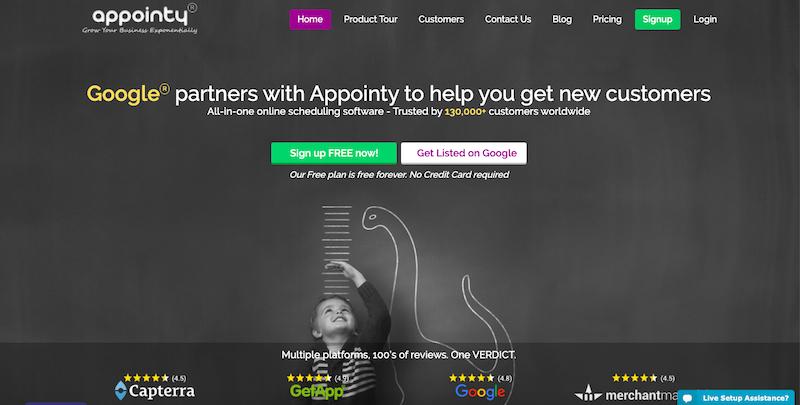
Appointy offers a powerful all-in-one online scheduling solution. It is best suitable for assisting users in driving vertical business growth.
Moreover, it comes equipped with an intuitive user interface that is functional yet simple enough for people who are not friendly with technology. The software is one of the most preferred choices for small and medium businesses.
Key Features:
- It comes with a simple integration that can be done easily within a few minutes.
- It is capable of managing a large number of employees and several locations efficiently.
- Appointy can help businesses implement customer loyalty programs to retain existing customers easily.
- It allows customers to schedule appointments through Facebook and the website.
- Businesses with no website can leverage Appointy’s subdomain to create a unique booking page.
- Appointy enables customers to make recurring appointments and bookings.
- It adjusts business hours to help customers make appointments at their own convenient time.
- It offers real-time notifications that can be checked from anywhere through mobile devices.
- The offers capable reporting and analytics tools to track the performance of staff and appointments.
- It sends automated reminders through emails and SMSes to reduce the number of no-shows.
Cons:
- Customer support is not robust.
- Syncing issues with third-party applications.
Cost:
The paid plans start from $19.99 per month and range up to $79.99 per month. You also get a free trial for 14-days and a free plan for your basic requirements.
9. SuperSaaS.

SuperSaaS offers appointment scheduling services for any type of business. You can leverage this highly customizable software for one-on-one scheduling, reservations & rentals, group scheduling, and service appointment booking, among others. The best part is that it integrates with plenty of third-party tools and offers a user-friendly interface.
Key Features:
- It offers seamless integration with the website and Facebook with a ‘Book Now’ button. You can also use it as a standalone appointment booking system for businesses that don’t have a website or Facebook account.
- SuperSaaS is capable of sending automated reminders via SMS and email reduces the possibility of late arrivals and no shows.
- The tool can accept payments from customers through Stripe, PayPal, and credit cards.
- It offers growing businesses a highly scalable solution to accommodate unlimited users, increasing staff members, and other resources.
- Users can make bookings from any geography through mobile devices.
- It offers an automatic adjustment of the time zone and support for 34 languages.
- It easily syncs with Microsoft Outlook, Google Calendar, and phone calendar to avoid conflicts and duplicate bookings.
- Users get efficient integration with iCal for instant updates of appointments on the calendar.
Cons:
- The calendar has only one design.
- It shows the time zone of business to the client. That would mean that the customer from different time zone would see the wrong time.
Cost:
It offers a free version for a maximum number of 50 upcoming appointments. The paid plans start from $8 per month and go all the way to $46 per month.
10. Ganttic.
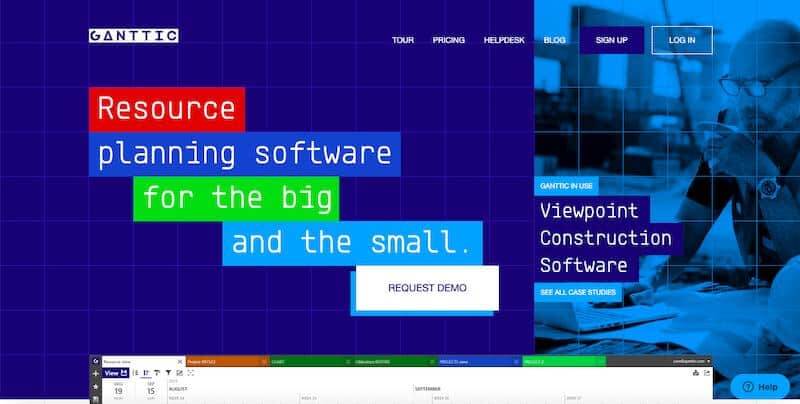
Ganttic is a highly capable planning tool that offers all the right resources to plan and manage your workflow and meetings. It comes equipped with the ability to efficiently schedule projects, facilities, people, and equipment, among others.
It also offers the option to visually plan everything through a simple drag and drop feature. Apart from offering a highly capable graphical interface, it also provides charts to run the show efficiently.
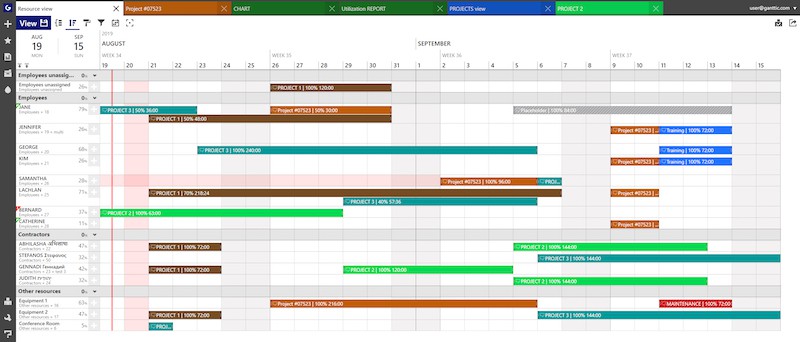
Key Features:
- It is capable of allowing real-time collaboration with an unlimited number of users.
- Leverage drag and drop scheduling to easily create tasks, edit details, and add any amount of custom data.
- Plan the work resources based on the time duration required or the level of effort needed.
- You can have separate views for different projects and use a general view to keep an eye on all the projects.
- Use charts and resource utilization calculations to avoid under or overstaffing in any project.
- Generate graphs and custom reports to analyze projects, tasks, and resources, among others.
- It allows the allocation of the same task to multiple resources.
- Offers Facebook Page integration.
- Leverage time tracking to calculate efficiency and make better resource planning in the future.
- Use iOS and Android mobile apps to stay connected on the go.
- You can sync it with the phone calendar and Outlook calendar to avoid conflicts and duplicate tasks.
Cons:
- It requires a steep learning curve.
- It might take longer than expected to integrate for complex tasks.
Cost:
Ganttic is free for up to 10 resources. It offers a 14-days free trial for the paid plans that start from $25 per month.
11. Square Appointments.

Over the years, Square Appointments has grown to more than just scheduling and booking software. It now offers a fully-functional point of sale system (POS) that is also capable of taking payments, create a discount, and accept tips, among others. Moreover, it is a perfect pick for health and wellness businesses.
Key Features:
- Businesses can efficiently embed booking buttons and appointment widgets into their website.
- It supports automatic updates of services, schedules, and prices across channels.
- Businesses that don’t have a website can leverage Square’s free booking website and can include a plethora of features, including staff bios, services, calendars, pricing, and cancellation policies.
- Users can also send personalized messages to clients to achieve higher customer satisfaction.
- Business owners can work on multiple devices as the software’s sync functions seamlessly across platforms and devices.
- Appointment confirmations and reminders are sent automatically via emails and SMS.
- Users can book multiple services at the same time.
- It comes bundled with apps for smartphones and tablets.
- Customers can leverage Square Assistant to make or reschedule appointments via digital chat.
Cons:
- It offers limited customization options.
- Features might look basic for large enterprises.
- It is relatively expensive in comparison to the services of other competitors.
Cost:
It offers a free trial for individual use. The paid plans start from $50 per month. You also get a 30-day free trial for the paid plans.
12. Bookwhen.

Bookwhen meets the scheduling requirements of businesses of all shapes and types. It offers a plethora of robust features and elements, including custom booking forms, the capability to export bookings to Excel, and more. Moreover, the software is easy to use and integrate.
Key Features:
- Businesses can customize booking forms for every event, validate responses, and opt-in for marketing.
- It allows online payment through Paypal, Stripe, and WorldPay. You can also provide a ‘Pay Later’ option to accept offline payment or other modes of payments.
- Confirmation and reminder email carry essential information, including a link through which customers can manage the booking, calendar file, and customizable text that is sent by the business.
- Leverage online register to mark attendance.
- A single user can make multiple appointments or bookings. It also offers recurring bookings.
- Use a simple code to embed the booking widget on any website including Wix, WordPress, and Squarespace.
- It is perfectly optimized for mobile devices.
- It is available in multiple languages, including English, Italian, Danish, Dutch, German, Swedish, French, Spanish, and Hungarian.
- Its Franchisors feature allows the deduction of commission automatically from partner outlets.
Cons:
- Their chat support works only on weekdays.
- Businesses can’t reschedule the appointment.
Cost:
It offers a free version that allows up to 50 bookings per month. The paid plans start from $15 per month and range up to $59 per month.
13. SkedPal.

SkedPal is highly user-friendly scheduling application. The software works wonders for people who are always busy and want to streamline their workflow to gain efficiency. Moreover, it is perfectly apt for every professional, be it an entrepreneur or a freelancer.
Key Features:
- It offers apps for all platforms, including Windows, Mac, and Linux. Smartphone apps for iOS and Android help users stay connected and productive from any location.
- SkedPal allows users to create habits that recur on a monthly, weekly, or daily basis. It assists users in free time to achieve these goals and habits.
- It seamlessly integrated with Outlook, Google, Office 365, and iCloud calendars to ensure there are no duplicate bookings and conflicts.
- Simply tell SkedPal about the things you want to accomplish, and its AI engine will automatically collate all your priorities that need attention.
- Leverage its Time Map feature to plan your week efficiently by budgeting the time for different things, including work, hobbies, and meetings. It all happens with a click of a button.
Cons:
- The mobile application is not as smooth as desktop applications.
- Time tracking is absent.
Cost:
SkedPal costs $9.95 per month per user and is billed annually. You also get a 14-day free trial to check whether the tool aligns with your requirements or not.
14. Setster.
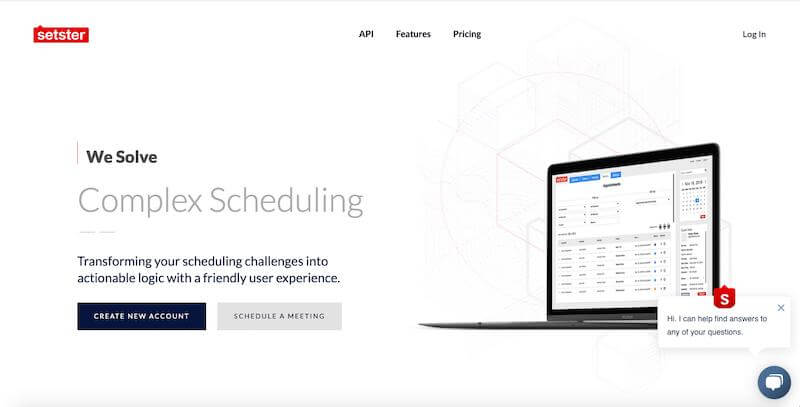
Setster is an enterprise online appointment scheduling tool. It helps you simplify your complex scheduling challenges through a friendly user interface and an actionable logic.
Moreover, Setster offers an omnichannel experience to promote efficiency and encourage more customer engagement.
Key Features:
- It allows specific settings and rules for every appointment you make, depending upon the clients you are meeting.
- It allows the linking of team members from any location, including virtual or geographical.
- Users can avoid back to back appointments through padding. It allows adding a buffer time to get ready for the next meeting quickly.
- Businesses can send advance notice of the appointment to avoid no shows and later arrivals.
- Control the availability of team members by blocking time off and adding holidays.
- You can directly accept payment in your account through PayPal, Stripe, and FreshBooks. It also allows the customer to make the payment in person after the completion of the appointment.
- It offers an API for highly customized integration of the application.
- Get seamless integration with third-party applications, including Salesforce and Zapier.
- Efficiently syncs with Office 365, Outlook.com, and Google calendar to make sure all the planned workflow stays at one screen.
- Deliver notifications to customers at customized times for higher engagement.
- Customers can also request the appointment time before getting a final confirmation.
Cons:
- Integration with Salesforce is not reliable.
- It is one of the priciest options available.
Cost:
The paid plans start from $20 per month and go all the way up to $300 per month. You can also get a discount of 20 percent on annual subscriptions.
15. EngageBay.
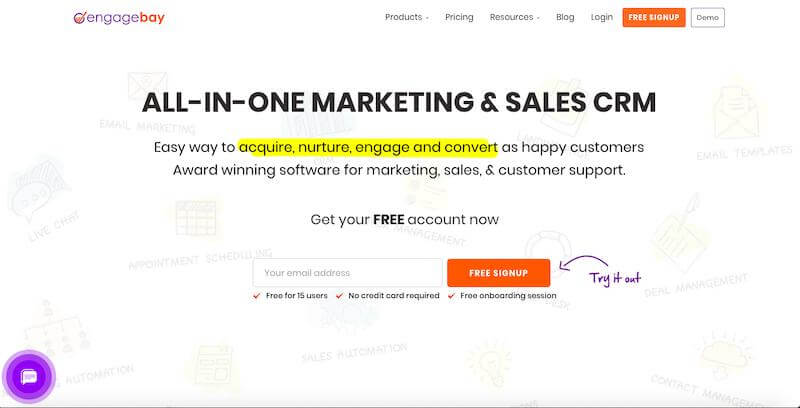
EngageBay goes beyond just scheduling and aims to solve a ton of different marketing challenges. Trusted by over 12,000 businesses, the software combines the efficiency of sales, marketing, and services in one solution.
Key Features:
- It offers great personalization options to send highly engaging emails to customers.
- Enable faster scheduling of appointments by helping customers book appointments.
- Automatically sync appointment from Google or Office 365 to ensure you have the most updated list of day schedule.
- Allows group appointments that enable the customer to make appointments with more than one person of your organization through a single booking.
- Show the time slots based on your availability. Users can also set the availability based on different time zones to avoid any kind of confusion.
- Set up form fields to gather valuable information of clients that you could later use to generate leads.
- It intimates customers about the upcoming appointments well in advance through automated reminders.
- The software is available free of cost.
Cons:
- It offers limited features, which makes it suitable for small businesses only.
- The user interface could be more intuitive.
Cons:
The tool is available entirely free of cost for up to 15 users. After that, the pricing plans start from $8.99 /user per month.
16. InviteOnce.

InviteOnce aims to take charge of all your business bookings. It offers efficient scheduling of multiple appointments in a flash. It’s capable of catering to various industries, including B2B SaaS, financial services, consulting, healthcare, lifestyle, and education sectors.
Key Features:
- You can customize each meeting through individual settings, including location and time.
- Its “Round Robin” feature ensures equal distribution of work among team members.
- It maximizes the availability of resources by combining the professionals of different teams. This helps in minimizing cancellations and bounce rates.
- Its scheduling engine automatically selects the most suitable time slot depending upon the requirement of the meeting.
- You can embed a suggested meeting time in the email so that the customer can instantly confirm the meeting through a single click.
- Create meeting templates instantly to gauge the requirement of your organization efficiently. Users can easily create a new template through a single click.
Cons:
- Integration with Instagram and other social media channels is not seamless.
- It has some bugs that might cancel the scheduled appointment or show empty slots as booked slots.
Cost:
The paid plans start at $10 per month. The good news is that you get a free trial for 14-days to discern whether it is a perfect fit for you or not.
17. Nowsta.

Nowsta is a capable employee scheduling tool that is suitable for businesses of every scale. The software is ideal for various industries to streamline workflow by optimizing payroll process, shift management, scheduling, and time tracking.
Key Features:
- Businesses can leverage filters and tags to find the most suitable resources for the task and send them work requests.
- There is a conflict notification to avoid double booking.
- Overtime warnings allow you to schedule employees, track time, swap shifts and deal with schedule changes.
- Employees can access and respond to work requests through mobile apps to minimize work time.
- Its GPS enabled punch feature helps in tracking the location of employees and ensure that people are actually at work.
- It automatically flags gaps by matching the tracked hours against the schedule of an employee.
- It leverages photo verification instead of body punching for more robust and secure access in the system.
- It automatically prepares wages based on the logged hours.
- It offers robust and seamless integration with third-party payroll applications.
Cons:
- The time clock application is not error-free.
- It might log out the user abruptly without giving any reason.
Cost:
Nowsta is one of the most cost-efficient employee scheduling apps. Its paid plans start from $2 per month per user.
18. UpKeep.

UpKeep is an advanced maintenance and asset management tool that is most suitable for large teams. Users can access all the features of UpKeep easily from desktops, tablets, and smartphones from any location around the globe.
It enables professionals to have efficient communication with workers on the go. Some of its most prominent features include maintaining the workflow automatically, preventive maintenance, downtime tracking, keeping checklists, and so forth.
Key Features:
- Leverage its real-time notifications and alerts to create work orders from anywhere, receive alerts and notifications of updated tasks on your smartphone.
- Prevent recurring trends by reviewing reports regularly to maximize the uptime.
- It offers secured storage of data in the cloud and takes backup regularly.
- You can access work orders and requests from anywhere through tablet and smartphone applications.
- Monitor inventory, assets, and locations from a single point.
- It offers a user-friendly interface that can be leveraged by users of different technological expertise.
- It can be implemented quickly and requires a low learning curve.
- Gets regular updates to incorporate enhancements and new features.
Cons:
- It is incapable of creating bulk orders efficiently.
- The free version comes with limited features.
- The user interface could become more intuitive to ensure more efficient functioning.
Cost:
UpKeep offers a free version. The paid plans start at $35 per month, billed annually.
What is Scheduling Software?
Scheduling software is a software-as-a-service (SaaS) tool perfect to help businesses manage appointments, bookings, employee scheduling, or project management tasks.
Moreover, it’s capable of automating the process of scheduling appointments along with a lot of other features, including cancellation of bookings, online payments, helping you connect with different stakeholders, and more. It also allows businesses to eliminate mistakes, miscommunications, and duplicate reservations.
If you want your enterprise to become more customer-friendly and agile, then you might also want to try out one of the scheduling platforms mentioned in this article.
What Should You Look For in Scheduling Software?
When you start your search for the right software solutions, you are likely to get overwhelmed by all the options available. It becomes challenging to figure out the key differentiators and make the right decision.
Here are a few essential points that you must consider while searching for the right scheduling software:
1. Scheduling Features.
Most online scheduling software platforms come with numerous attractive features and elements. But you need to choose the one whose features meet all your requirements. Look for a scheduling software tool that offers functionalities that are capable of making your business process smooth and efficient. Don’t get swayed by extraordinary features, instead put your priorities first.
2. Third-Party Integrations.
Make sure that the scheduling platform you choose offers robust and seamless integration with website, social media applications, and other third-party applications. It would help you keep omnichannel connect with resources and customers.
Take InviteOnce, for instance:
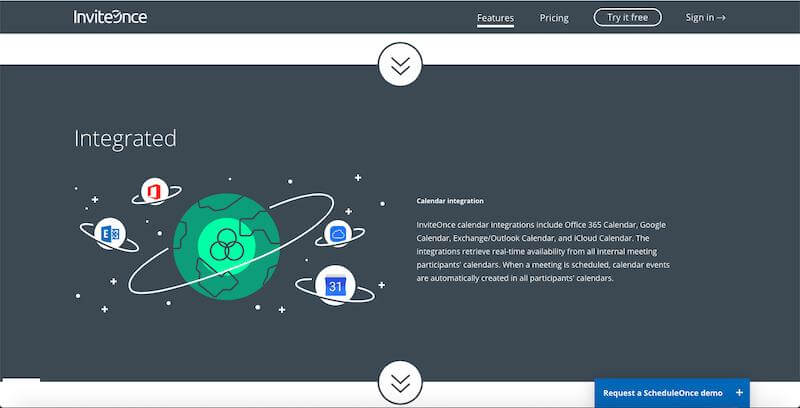
It enables integration with vital third-party tools like Office 365 Calendar, Google Calendar, Exchange/Outlook Calendar, and iCloud Calendar. These integrations allow InviteOnce to retrieve real-time availability and make things more streamlined.
3. Compatibility.
Make sure to look for a scheduling platform that provides efficient compatibility with all platforms and devices. You might also want to look for an option that offers a mobile app to ensure smooth and seamless access to your entire business schedule.
4. Scalability.
If you are a small business but riding on a high growth rate, then it would be wise to go for highly scalable scheduling software. It is essential to ensure that the platform would be able to meet your expanding requirements in the future. Therefore, check the number of users it supports and how many customers it can handle in a single point in time.
5. Customer Support.
Look for a scheduling platform that offers omnichannel customer support to help resolve issues. Also, make sure to check whether the platform assists with the setup or not.
Consider these points to judge each option more critically and single out suitable options easily.
Executive Summary.
So, there you have it — some of the best scheduling software available online today. However, to make the right pick, you first need to analyze the requirements of your organization.
Here are a few points that you must keep in mind before selecting the right scheduling software:
- Number of Employees: If you are a freelancer or run a business with a small team, then select the free version that offers decent features. However, if you have a company with a bigger team, then go for an enterprise plan that provides the best value for your money.
- Type of Business: Your business might require the software for the booking of tickets, appointment scheduling, or distribution of tasks. Select a platform that meets your specific scheduling needs instead of going for a tool that offers loads of useless features.
- Budget: Make sure that the platform you choose is under your budget and offers the best value for money. Compare prices against features of other options to get the best bargain. Look for free versions if you have a small team or simple requirement
Great info! I recently came across your blog and have been reading along. I thought I would leave my first comment. I don’t know what to say except that I have.It’s time to avail this ACH Services For Small Business for more details.
ReplyDelete